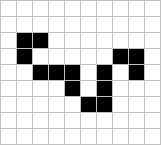Eater bridge eater
Eater bridge eater is a 14-cell still life commonly used in signal converter circuitry, composed of two diagonally-touching eater 1s. In the F116 and Fx176 Herschel conduits, its two component eaters have standard eating functions. In the 135-degree MWSS-to-G, 30P6.1 and 60P72, the catalyst is on the opposite side of the object, and the slightly smaller snake bridge behind eater tail can be used instead. In the case of the MWSS-to-G, there are known recipes that allow the eater-bridge-eater variant to be constructed with slow salvos in any orientation, so this variant is more commonly used.
| Eater bridge eater | |||||||||||
| |||||||||||
| View static image | |||||||||||
| Pattern type | Strict still life | ||||||||||
|---|---|---|---|---|---|---|---|---|---|---|---|
| Number of cells | 14 | ||||||||||
| Bounding box | 8×5 | ||||||||||
| Frequency class | 27.9 | ||||||||||
| Discovered by | Unknown | ||||||||||
| Year of discovery | Unknown | ||||||||||
| |||||||||||
| |||||||||||
| |||||||||||
| |||||||||||
A more precise name for this still life is Mark Niemiec's Eater tail bridge behind eater tail. This is too long and technical to find its way into common usage, but it correctly distinguishes this object from related still lifes such as eater tail bridge eater tail, eater head tie up eater head, eater head tie down eater head, eater head bridge eater tail, and eater head behind eater.
Eater tie eater and welded eaters have also been used to refer to this still life on occasion, but both of these terms are technically incorrect. A weld implies an overlap between welded objects, and a tie is a point-to-point connection along the lines of a boat-tie. The name eater tie eater has been in use for many years in Mark Niemiec's database, referring to a different object.
